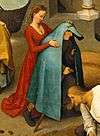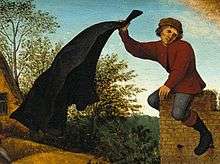The Blue Cloak
The Blue Cloak, or De Blauwe Huik, refers to an old concept for a popular 16th-century print series featuring Flemish proverbs. The prints were generally captioned according to each depicted proverb, and central to these was a woman pulling a cloak over a man. That proverb is also central to a 1559 painting called Netherlandish Proverbs by Pieter Bruegel the Elder.
.jpg)
That painting, dated 1559, is considered the best of a series of similar paintings which at one time or other have all previously been attributed to Pieter Bruegel the Elder, has been x-rayed for its underdrawing to compare it to other versions. None of the versions have a provenance going back further than the late 19th-century, but Brueghel scholars believe that the paintings are the elder Bruegel's inventions, which all make use of a life-size cartoon with the same underdrawing as that used in the Berlin version.[1] The paintings, which are not inscribed, tease the viewer into guessing proverbs. They are based on 1558 and earlier engravings that are inscribed, in Flemish. The most notable of these regarding the paintings is by Frans Hogenberg, and it is dated 1558 and accompanied by the title Die blau huicke is dit meest ghenaemt, maer des weerelts abvisen he beter betaempt (English: Often called 'The Blue Cloak', this could better be called 'The World's Follies'). The Doetecum brothers produced a print series in 1577 called De Blauwe Huyck. Theodoor Galle also made a print, dated later, with a similar title: Dese wtbeeldinghe wort die blauw hvyck genaemt, maer deze werelts abvysen haer beter betaemt.[2]
Some of the paintings:
 Gemäldegalerie, Berlin
Gemäldegalerie, Berlin Rockox House, Antwerp
Rockox House, Antwerp Private collection
Private collection Frans Hals Museum, Haarlem
Frans Hals Museum, Haarlem Noord Brabantsmuseum, Den Bosch
Noord Brabantsmuseum, Den Bosch Stedelijk Museum Wuyts-Van Campen en Baron Caroly, Lier
Stedelijk Museum Wuyts-Van Campen en Baron Caroly, Lier
In the print versions, the blue cloak or huik plays the central role:
 Hogenberg, 1558
Hogenberg, 1558 Doetecum, 1577
Doetecum, 1577 Galle, 1571-1633
Galle, 1571-1633
Later versions: The painter David Teniers the Younger, who married Brueghel's granddaughter, also made a painting with his own modern interpretation of the same proverbs in 1645, which also surround a central "Blue cloak" scene:
Meaning
The central figure is a woman who is pulling a blue cloak over her husband. She is literally pulling the wool over his eyes. This act is a metaphor for adultery, explicitly the adultery of the woman, and the cloak a deceitful "coverup" that helps her husband to "not see it", which is also indicated by another proverb or expression in the Galle engraving showing a man with his fingers in front of his eyes with the remark "Dese siet door de vingeren" (English: This one acts blind but is 'peeking through his fingers').
 Breughel
Breughel.jpg) Hogenberg
Hogenberg.jpg) Galle
Galle
Cloak color

.jpg)
The cloak was called a 'huyck' (huik in modern Dutch), and it was a black garment that was worn by upperclass women when they went outside the home from the 16th century onwards. It is unknown why the color blue of the huik plays a role in the proverb. That the huik was meant to be blue was emphasized not only by the common title, but also by the use of a black huik elsewhere in the painting. This secondary appearance of the huik can also be seen in the Hogenberg and Galle engravings, though it doesn't play a central role.
References
- Breughel Enterprises, 2001-2002 exhibition on the work of Pieter Brueghel II's copies after his father's works, Historians of Netherlandish Art review
- C. C. Barfoot and Richard Todd, The Great Emporium: the Low Countries as a cultural crossroads in the Renaissance and the eighteenth century (1992), p. 128; Google Books.
